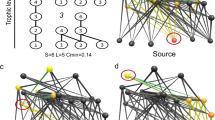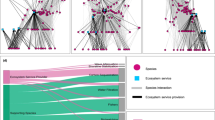Abstract
Indirect effects of biological control agents (BCAs) are difficult to assess because they are mediated through the complex connections between species within the ecological community. Being able to visualise such complex connections by constructing qualitative food webs could greatly enhance our ability to predict indirect effects that could then be evaluated through empirical studies or modelling. Qualitative food webs were constructed for two case studies of entomophagous BCAs using the existing literature on invertebrate consumer relationships and status (e.g., as pest or rare species). We suggest that these webs can reduce uncertainty around the species that may be at risk, can predict species that perhaps should be monitored post-release, or identify knowledge gaps on species and their feeding relationships prior to the release of a BCA. Thus, these webs may be useful for those who need to consider the potential indirect risks of BCAs when making decisions about the release of a BCA into new regions.


Similar content being viewed by others
References
Andersen MC, Ewald M, Northcott J (2005) Risk analysis and management decisions for weed biological control agents: Ecological theory and modeling results. Biol Control 35:330–337
Anon (1996) Hazardous substances and new organisms act 1996. New Zealand Government, Wellington, New Zealand
Avila GA, Berndt LA, Holwell GI (2013) First releases and monitoring of the biological control agent Cotesia urabae Austin and Allen (Hymenoptera: Braconidae). N Z Entomol 36:65–72
Avila GA, Charles JG (2018) Modelling the potential geographic distribution of Trissolcus japonicus: a biological control agent of the brown marmorated stink bug, Halyomorpha halys. BioControl 63:505–518
Avila GA, Withers TM, Holwell GI (2016) Retrospective risk assessment reveals likelihood of potential non-target attack and parasitism by Cotesia urabae (Hymenoptera: Braconidae): a comparison between laboratory and field-cage testing results. Biol Control 103:108–118
Babendreier D, Bigler F, Kuhlmann U (2005) Methods used to assess non-target effects of invertebrate biological control agents of arthropod pests. BioControl 50:821–870
Barratt BIP, Ferguson CM, Goldson SL, Phillips CM, Hannah DJ (2000) Predicting the risk from biological control agent introductions: A New Zealand approach. In: Follett PA, Duan JJ (eds) Nontarget effects of biological control. Kluwer Academic, Boston, pp 59–75
Barratt BIP, Howarth FG, Withers TM, Kean JM, Ridley GS (2010) Progress in risk assessment for classical biological control. Biol Control 52:245–254
Berndt LA (2010) Will competition from Meteorus pulchricornis (Wesmael) (Hymenoptera: Braconidae) limit the success of the potential biocontrol agent Cotesia urabae Austin & Allen (Hymenoptera: Braconidae)? Aust J Entomol 49:369–376
Berndt LA (2011) Wasp released to control gum leaf skeletoniser. Biosec Mag 102:14–15
Berry JA (1997) Meteorus pulchricornis (Wesmael) (Hymenoptera: Braconidae: Euphorinae), a new record for New Zealand. N Z Entomol 20:45–48
Carvalheiro LG, Buckley YM, Ventim R, Fowler SV, Memmott J (2008) Apparent competition can compromise the safety of highly specific biocontrol agents. Ecol Lett 11:690–700
Charles JG, Avila GA, Hoelmer KA, Hunt S, Gardner-Gee R, MacDonald F, Davis V (2019) Experimental assessment of the biosafety of Trissolcus japonicus in New Zealand, prior to the anticipated arrival of the invasive pest Halyomorpha halys. BioControl 64:367–379
Charles JG, Sandanayaka M, Chhagan A, Page-Weir NEM (2013) Host selection behaviour in Mastrus ridens, a gregarious ectoparasitoid of codling moth, Cydia pomonella. BioControl 58:493–503
Clarke AR, Seymour JE (1992) Two species of Acroclisoides Girault and Dodd (Hymenoptera: Pteromalidae) parasitic on Trissolcus basalis (Wollaston) (Hymenoptera: Scedionidae), a parasitoid of Nezara viridula (L.) (Hemiptera: Pentatomidae). J Aust Entomol Soc 31:299–300
Cumber RA (1951) The introduction into New Zealand of Microphanurus basalis Woll. (Scelionidae: Hym.), egg-parasite of the green vegetable bug, Nezara viridula L. (Pentatomidae). N Z J Sci Technol 32:30–37
Cumber RA (1964) The egg-parasite complex (Scelionidae: Hymenoptera) of shield bugs (Pentatomidae, Acanthosomidae: Heteroptera) in New Zealand. N Z J Sci 7:536–554
De Clercq P, Mason PG, Babendreier D (2011) Benefits and risks of exotic biological control agents. BioControl 56:681–698
Denslow JS, D'Antonio CM (2005) After biocontrol: assessing indirect effects of insect releases. Biol Control 35:307–318
Fowler SV, Gourlay AH, Hill R (2016) Biological control of ragwort in the New Zealand dairy sector: an ex-post economic analysis. N Z J Agric Res 59:205–215
Gresham B, Kay M (2017) Parasitoids of Nyctemera annulata (Boisduval) (Lepidoptera: Erebidae). Weta 51:30–35
Heimpel GE, Cock MJW (2018) Shifting paradigms in the history of classical biological control. BioControl 63:27–37
Holt RD, Hochberg ME (2001) Indirect interactions, community modules and biological control: a theoretical perspective. In: Wajnberg E, Scott JK, Quimby PC (eds) Evaluating indirect ecological effects of biological control. CABI Publishing, Wallingford, pp 13–37
Kaufman LV, Wright MG (2017) Assessing probabilistic risk assessment approaches for insect biological control introductions. Insects 8:67
Kimberling DN (2004) Lessons from history: predicting successes and risks of intentional introductions for arthropod biological control. Biol Invasions 6:301–318
Lara JR, Pickett CH, Kamiyama MT, Figueroa S, Romo M, Cabanas C, Bazurto V, Strode V, Briseno K, Lewis M, Oliva J, Hernandez G, Hoddle MS (2019) Physiological host range of Trissolcus japonicus in relation to Halyomorpha halys and other pentatomids from California. BioControl 64:513–528
Larivière M-C, Larochelle A (2004) Fauna of New Zealand: Heteroptera (Insecta: Hemiptera): catalogue no. 50. Manaaki Whenua – Landcare Research, Lincoln
Leskey TC, Nielsen AL (2018) Impact of the invasive brown marmorated stink bug in North America and Europe: History, biology, ecology, and management. Annu Rev Entomol 63:599–618
López-Núñez FA, Heleno RH, Ribeiro S, Marchante H, Marchante E (2017) Four-trophic level food webs reveal the cascading impacts of an invasive plant targeted for biocontrol. Ecology 98:782–793
Louda SM, Rand TA, Russell FL, Arnett AE (2005) Assessment of ecological risks in weed biocontrol: Input from retrospective ecological analyses. Biol Control 35:253–264
Lynch LD, Hokkanen HMT, Babendreier D, Bigler F, Burgio G, Gao ZH, Kuske S, Loomans A, Menzler-Hokkanen I, Thomas MB, Tommasini G, Waage JK, van Lenteren JC, Zeng QQ (2001) Insect biological control and non-target effects: a European perspective. In: Wajnberg E, Scott JK, Quimby PC (eds) Evaluating indirect ecological effects of biological control. CABI Publishing, Wallingford, pp 99–125
Melbourne-Thomas J, Wotherspoon S, Raymond B, Constable A (2012) Comprehensive evaluation of model uncertainty in qualitative network analysis. Ecol Monogr 82:505–519
Memmott J (2000) Food webs as a tool for studying nontarget effects in biological control. In: Follett PA, Duan JJ (eds) Nontarget effects of biological control. Kluwer Academic, Boston, pp 147–163
Messing R, Roitberg B, Brodeur J (2006) Measuring and predicting indirect impacts of biological control: competition, displacement and secondary interactions. In: Bigler F, Babendreier D, Kuhlman U (eds) Environmental impact of invertebrates for biological control of arthropods: Methods and risk assessment. CABI Publishing, Wallingford, pp 64–77
Ollivier M, Lesieur V, Raghu S, Martin JF (2020) Characterizing ecological interaction networks to support risk assessment in classical biological control of weeds. Curr Opin Insect Sci 38:40–47
Patrick B (2020) 'Butterflies and moths - Life cycle', Te Ara - the Encyclopedia of New Zealand. https://www.TeAra.govt.nz/en/photograph/11137/magpie-moth-caterpillar. Accessed 12 May 2020
Pearson DE, Callaway RM (2005) Indirect nontarget effects of host-specific biological control agents: implications for biological control. Biol Control 35:288–298
Puccia CJ, Levins R (1985) Qualitative modeling of complex systems: an introduction to loop analysis and time averaging. Harvard University Press, Cambridge, MA
Rice KB, Bergh CJ, Bergmann EJ, Biddinger DJ, Dieckhoff C, Dively G, Fraser H, Gariepy T, Hamilton G, Haye T, Herbert A, Hoelmer K, Hooks CR, Jones A, Krawczyk G, Kuhar T, Martinson H, Mitchell W, Nielsen AL, Pfeiffer DG, Raupp MJ, Rodriguez-Saona C, Shearer P, Shrewsbury P, Venugopal PD, Whalen J (2014) Biology, ecology, and management of brown marmorated stink bug (Hemiptera: Pentatomidae). J Integr Pest Manag 5:A1–A13
Smith R, Mangan R, Coetzee JA (2019) Risk assessment to interpret the physiological host range of Hydrellia egeriae, a biocontrol agent for Egeria densa. BioControl 64:447–456
Sutton GF, Paterson ID, Compton SG, Paynter Q (2017) Predicting the risk of non-target damage to a close relative of a target weed using sequential no-choice tests, paired-choice tests and olfactory discrimination experiments. Biocontrol Sci Technol 27:364–377
Talamas EJ, Herlihy MV, Dieckhoff C, Hoelmer KA, Buffington M, Bon M-C, Weber DC (2015) Trissolcus japonicus (Ashmead) (Hymenoptera, Scelionidae) emerges in North America. J Hymenoptera Res 43:119–128
Taylor DBJ, Dhileepan K (2018) The host specificity of Anomalococcus indicus Ayyar (Hemiptera: Lecanodiaspididae), a potential biological control agent for prickly acacia (Vachellia nilotica ssp indica) in Australia. Biocontrol Sci Technol 28:1014–1033
Valentine EW (1967) A list of the hosts of entomophagous insects in New Zealand. N Z J Sci 10:1100–1209
van Driesche RG, Reardon R (2004) Assessing host ranges for parasitoids and predators used for classical biological control: a guide to best practice. USDA Forest Service, Morgantown, West Virginia
van Lenteren JC, Bale J, Bigler F, Hokkanen HMT, Loomans AM (2006) Assessing risks of releasing exotic biological control agents of arthropod pests. Annu Rev Entomol 51:609–634
van Veen FJF, Memmott J, Godfray HCJ (2006) Indirect effects, apparent competition and biological control. In: Brodeur J, Boivin G (eds) Trophic and guild in biological interactions control. Springer, pp 145–169
Veldtman R, Lado TF, Botes A, Proches S, Timm AE, Geertsema H, Chown SL (2011) Creating novel food webs on introduced Australian acacias: indirect effects of galling biological control agents. Divers Distrib 17:958–967
Walker GP, MacDonald FH, Wallace AR, Cameron PJ (2016) Interspecific competition among Cotesia kazak, Microplitis croceipes, and Meteorus pulchricornis (Hymenoptera: Braconidae), larval parasitoids of Helicoverpa armigera (Lepidoptera: Noctuidae) in New Zealand. Biol Control 93:65–71
Wesner J (2019) Using stage-structured food webs to assess the effects of contaminants and predators on aquatic-terrestrial linkages. Freshw Sci 38:928–935
Willis AJ, Memmott J (2005) The potential for indirect effects between a weed, one of its biocontrol agents and native herbivores: a food web approach. Biol Control 35:299–306
Wright MG, Bennett GM (2017) Evolution of biological control agents following introduction to new environments. BioControl 63:105–116
Wyckhuys KAG, Wongtiem P, Rauf A, Thancharoen A, Heimpel GE, Le NTT, Fanani MZ, Gurr GM, Lundgren JG, Burra DD, Palao LK, Hyman G, Graziosi I, Le VX, Cock MJW, Tscharntke T, Wratten SD, Nguyen LV, You MS, Lu YH, Ketelaar JW, Goergen G, Neuenschwander P (2018) Continental-scale suppression of an invasive pest by a host-specific parasitoid underlines both environmental and economic benefits of arthropod biological control. PeerJ 6:e5796
Acknowledgements
We would like to thank Melanie Davidson and Gonzalo Avila for their useful comments on draft versions of this manuscript, and also the anonymous reviewers as part of the peer-review process. We are also extremely grateful to Donna Gibson for producing the figures.
Funding
This study was funded by the New Zealand Government as part of the Better Border Biosecurity (B3) (https://www.b3nz.org.nz/) research collaboration.
Author information
Authors and Affiliations
Corresponding author
Ethics declarations
Conflict of interest
The authors declare that they have no conflict of interest.
Human and animal rights
There were no human or animal participants in this study.
Additional information
Handling Editor: Debora Pires Paula.
Rights and permissions
About this article
Cite this article
Todd, J.H., Pearce, B.M. & Barratt, B.I.P. Using qualitative food webs to predict species at risk of indirect effects from a proposed biological control agent. BioControl 66, 45–58 (2021). https://doi.org/10.1007/s10526-020-10038-7
Received:
Accepted:
Published:
Issue Date:
DOI: https://doi.org/10.1007/s10526-020-10038-7




